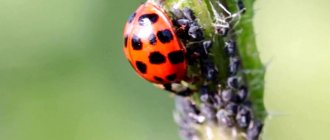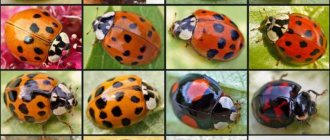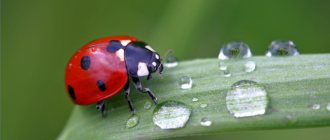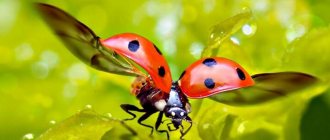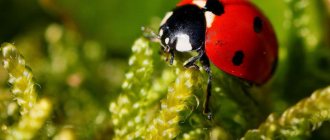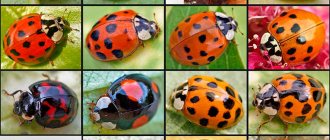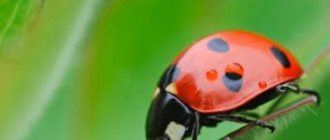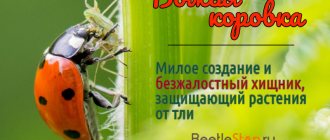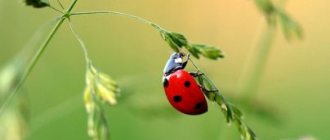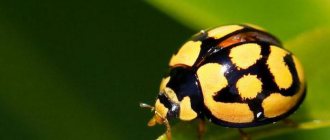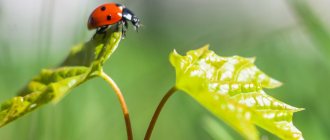- Ladybug: description, structure, characteristics. What does a ladybug look like?
Ladybug, fly to heaven, bring us bread, black and white, but not burnt. (Children's song).
Among all the insects that live in our latitudes, it is the ladybug that enjoys the greatest respect and honor. After all, even the name itself - “ladybug” speaks of a certain divinity of this creature. Why is the ladybug a ladybug? What habits does this insect have, what types of ladybugs are there, where they live, what they eat and many other interesting things about them, read on.
Where does the name ladybug come from?
The ladybug received its unusual name due to its bright red color, which aroused the sympathy of people. So, for example, in Slovenia and the Czech Republic it was called the “sun” (Slunechko), in Germany and Switzerland it is known as the “Virgin Mary’s bug”, in Latin America it is called “St. Anthony’s cow”. What is the origin of the name “ladybug”, there are two versions in this regard, according to the first, it was called “ladybug” for its ability to secrete poisonous milk, which scares off potential predators; our ladybug received the prefix “ladybug” for its meek and peaceful disposition. According to another version, these insects became “God’s” due to their ability to destroy aphids, thereby helping to preserve the crop.
Growing at home
Not all insects in natural conditions can withstand the cold. It's the same with bugs living in an artificial environment. Therefore, if you decide to start growing them, get pets in the spring. The chances that your insects will be healthy and viable will increase. Moreover, with the arrival of the first warm days, the activity of beetles is not yet high, they stay in groups, and it is not difficult to collect them.
A house for ladybugs can be a plastic terrarium with a lid, a plywood box with slots for air circulation, or a wooden cage with a covered top.
Dry leaves, small branches or wood shavings should be placed at the bottom of the box. In such conditions, the insects will be comfortable, they can live for several months, overwinter, and begin to mate in the spring.
Some gardeners and businessmen raise ladybugs at home in transparent plastic containers, make very small holes in the lid, or cover them with gauze or mosquito net and feed them with a mixture of yeast and sugar. Why do they do this? To then release them on your site to combat aphids or for sale to other gardeners.
To create comfortable conditions for the life and reproduction of ladybugs, small plants are planted in their housing, which are populated by aphids, so the ladybug finds itself almost in a natural habitat, can hunt and lead an active lifestyle. In captivity, ladybugs reproduce better than in nature, and at the same time, adult individuals remain living with their faces at the same time.
Ladybugs are insects popular due to their bright colors. The best habitat for ladybugs is the wild, but if you are lucky enough to find an insect near your home and want to take care of it, it is not difficult to do so - provide the ladybug with food, water and recreate the natural conditions of its habitat.
Description, structure, characteristics
According to the biological classification, the ladybug is an arthropod insect that belongs to the Coleoptera and the family of ladybirds.
The size of a ladybug ranges from 4 to 10 mm. The shape of their body is either round or oval-elongated, flat below and very convex above. The body surface of some types of ladybugs is covered with fine hairs. The structure of their body includes a head, a pronotum, a chest consisting of three sections, an abdomen, wings with elytra and three pairs of paws.
The ladybug's head is small (although in some species it may be slightly elongated), it is motionlessly connected to the anterior chest. But the ladybug's eyes are relatively large. The insect's antennae, which consist of 8-11 segments, are highly flexible.
The ladybug's pronotum is convex, has a transverse structure and a notch at the anterior edge. On its surface there are often “signature” spots of different shapes.
Thanks to the presence of three pairs of paws, the ladybug can move quite quickly both on the grass and along plant stems. The abdomen of ladybugs consists of five or six segments, which are covered from below by sternites (segmental semirings).
Despite the fact that ladybugs have two pairs of wings, they fly only with the help of their two hind ones. The front wings, in the process of evolution, were transformed into hard elytra, which serve as protection for the hind wings at the moment when the ladybug is on the ground.
As a means of protection against predators, ladybugs are capable of secreting a kind of poisoned “milk” - cantharidin, a toxic yellow liquid that also has an unpleasant odor. Additionally, the bright colors of the ladybug scare away enemies. The color of the ladybug's protective covers can be not only bright red, but also yellow, black, white with spots of different colors and different configurations. Sometimes the pattern on the pronotum of a cow can indicate its gender.
What does it look like?
The insect has a rounded, egg-shaped body, flattened at the bottom and convex at the top.
Juveniles most often have a bright red color (but other colors also exist).
On the back of the ladybug there are black dots with a diameter of 1–2 mm. However, their number varies and depends on the type of insect.
The body size ranges from 4 mm to 1 cm (maximum).
There are also flexible multi-segmented antennae and hard, expressive elytra. Interesting fact! When flying, an insect makes an average of 85 beats per second.
Habitats
Ladybugs live over a wide geographical range, on almost all earthly surfaces.
continents with the exception of Antarctica and the polar Arctic regions. As for habitats, some of them prefer to live on plants where a colony of aphids has formed, others choose sedge and reeds along water bodies as a home, while others live in field grasses.
Nutrition
All ladybugs are predators, but the predators are very useful for humans, since they eat various harmful parasites: aphids,
ticks, small caterpillars. Sometimes during hunger they will not disdain even the eggs of the Colorado potato beetle. Some types of ladybugs also eat plant foods: mushroom mycelium, plant pollen, leaves and flowers of some trees.
Lifestyle
Regardless of the species, all ladybugs are not gregarious insects, but ardent individualists leading a separate lifestyle. They gather together only during their mating season for procreation, as well as for flights to warmer regions and wintering grounds. Since these insects love warmth, the species that live in our temperate latitudes gather in large flocks before the onset of winter cold and fly away like birds for the winter in places with a warmer climate.
Although there are sedentary individuals who also gather together in some secluded place during the winter cold, usually these are collapsed stones, fallen bark and tree foliage. With the onset of spring and warmth, they scatter across the meadows and grasses again.
What does the bright warning color mean?
It is no coincidence that the ladybug is endowed with a bright color - it helps to survive in harsh natural conditions and scares away various enemies (predatory insects, birds, etc.). This is also a kind of mimicry, like a chameleon’s ability to adapt to the color of its environment (foliage, trees, sand, etc.) for the purpose of self-preservation.
And bright colors are warning signals for the wild world, indicating the inedibility and, possibly, toxicity of a potential victim. There is even a theory in the scientific world that goes something like this: “ The brighter the color of an insect, the less likely it is to be attacked by a predator .” Therefore, the red coloring looks something like a stop sign for all sorts of enemies. However, with age, the scarlet color fades.
Types, photos and names
Zoologists identify 4,000 different species of ladybugs, divided into 7 subfamilies. We will describe the most interesting among them.
Two-spot ladybird
This is a beetle with a body length of up to 5 mm, with a dark red body and two black dots (hence the name).
Seven-spotted ladybird
It is this type of ladybug that is most common in Europe. Its size is 7-8 mm. Its elytra are painted red, there are three black spots on the sides, and the seventh is located near the head of the insect.
Twelve-spotted ladybug
This ladybug has a length of 6 mm, a bright pink or red color, and, accordingly, 12 black spots on the elytra.
Thirteen-spotted ladybird
This type of ladybug has as many as 13 spots against the background of red-brown elytra; some of its spots can merge with each other.
Asian ladybug
This ladybird is up to 7 mm long and is divided into two subspecies. One of them has a yellow wing cover with black spots, both large and small. The second subspecies is characterized by black coloration of the elytra, on which red-orange spots are visible.
Ocellated ladybird
This is a very large representative of the ladybird family, reaching up to 10 mm in length. It has red or yellow elytra and black spots surrounded by lighter rims.
Pointless ladybug
This is a very rare species; its characteristic feature is the absence of signature spots. Also, the red or brown body of the pointless ladybug is covered with small fibers.
Blue ladybug
This is another unusual member of the ladybug family, having a characteristic blue color. Such insects live exclusively in Australia.
Reproduction and development stages
Ladybugs reach sexual maturity, depending on the species, at 3-6 months of life. Their mating season begins in the spring. The male finds his chosen one by the characteristic smell that she emits during that period. A short time after mating, the female ladybug lays eggs, and often acts very wisely, laying them near aphid colonies in order to immediately provide future offspring with food.
Ladybug eggs are attached to the underside of the leaves; they are oval in shape with slightly tapered ends. There are up to 400 eggs in one clutch. Unfortunately, the females themselves die soon after laying eggs.
After 1-2 weeks, variegated ladybug larvae emerge from the eggs. They have an oval or flat shape. The surface of the larva's body is often covered with thin bristles or hairs. In the first days of their lives, they eat the shell of the egg from which they hatched, then neighboring eggs without or even with embryos (yes, ladybug larvae can be cannibals). Gradually gaining strength, they begin to eat the aphid colony.
The future ladybug remains in the larval state for 4-7 weeks, after which the pupation stage begins. The pupa is attached to a leaf of the plant and in this position, in the cocoon, spends 7-10 days; it is during this period that all body parts characteristic of a cow are formed. After this period, a fully formed adult appears.
Benefits and harms
The benefits of the ladybug, especially in our latitudes, are undeniable; the principle “the enemy of my enemy is my friend” works here. Ladybugs, by eating various insect pests, provide a great service to agricultural lands. Sometimes they are even specially bred in special places and then sprayed over fields and plantations infested with pests.
But among them there are also herbivorous species, most of them live in tropical areas, which can also harm agricultural crops.
Security
The ladybug is already listed in the Red Book in many countries, including Russia.
If this insect completely disappears, humanity will face an imbalance in nature and the active proliferation of dangerous pests, which will have to be destroyed chemically.
Therefore, today ladybugs are successfully bred in laboratory conditions , and then released into the fields. But in order to maintain balance, it is necessary to abandon the chemical destruction of aphids and direct general efforts to improve the ecological situation of the environment.
Ladybugs are amazing creatures of nature that bring great benefits to people (with the exception of herbivorous species). They protect crops from various kinds of parasites, thereby preserving the harvest and allowing humanity to do without chemicals. However, in recent years the number of these beneficial insects has noticeably decreased, so they are listed in the Red Book and attempts are being made to restore the population artificially.
Interesting Facts
Why is it called that?
Here are some of the versions of the origin of the name:
- In ancient times, the insect was personified with the thunder god - Perun.
The ladybug was credited with the ability to influence the weather and was perceived as a link between mortal people and the gods. - Catholics considered her a messenger of the Mother of God.
- The British associated the insect with the Virgin Mary.
But the most optimal and plausible version of why the bug was named so is that the insect secretes a poisonous white liquid (the so-called “milk”) to scare away predators. And “God’s”, probably because it helped fight aphids and other agricultural pests and did not harm humans.
Interesting fact! The Slavs considered the ladybug to be a direct messenger of the sun. Therefore, it was impossible to drive her away, much less kill her. Otherwise, you could “turn away” your luck.
Video
And finally, an interesting video about ladybugs.
Author: Pavel Chaika, editor-in-chief of Poznavaika magazine
When writing the article, I tried to make it as interesting, useful and high-quality as possible. I would be grateful for any feedback and constructive criticism in the form of comments on the article. You can also write your wish/question/suggestion to my email [email protected] or Facebook, with respect, the author.
Author page
